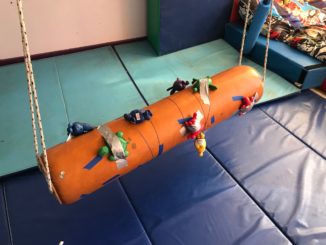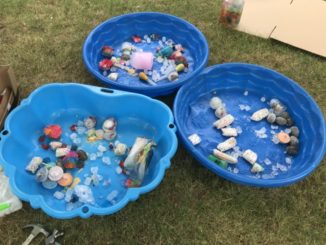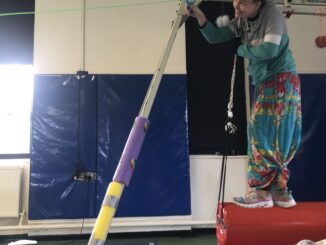I knew that among the play invitations that I had available at camp*, that I would want to have one more structured, writing-based invitation every day.
I wanted this for a variety of reasons: there were several older kids who were going to be coming to camp; writing and literacy is an avenue to so much fun and delight and I think that that’s not how it gets presented to kids or why it’s shown to be important, and I wanted the chance to show that to the kids plus also the adults; I would have been a kid who loved doing this activity, so, I wanted to create it.
Surprisingly, perhaps, for someone who’s *relatively* strong in their convictions, I really spent a lot of time deliberating over whether or not this activity could stand on its own or if it “needed” a prize. I didn’t *want* there to be a prize for literally anything at camp at all. I wanted everything to be its own intrinsic reward, and for children to only engage in it if they found it intrinsically rewarding. I have no problem standing in my confidence on this in my role as an OT, in my day to day job, working one on one with kids. Something about there being 30 of them at a time really made me question myself on this plan. What if someone’s parent forced them to do the scavenger hunt and they hated it and got to the end and were disappointed that they finished the whole thing and “got nothing” for it? What if, what if, what if…? I spent way too much brain power worrying about this. In the end, I went with what I thought was right. Like every other part of play offered at camp, participating in this play was its own reward.
We had 8 “mailboxes” made out of wallpaper-wrapped shoeboxes. Each day, they were set around the perimeter of the camp area. Each mailbox had a different paper clue or puzzle of some kind in it, that was inside of a page protector so it could be written on and wiped off with a dry erase marker. There were also clipboards and pens. The kids could take a clipboard and pen around to the different mailboxes and open them, solve the clue inside, write the answer on their clipboard, and so on until they had solved all 8!
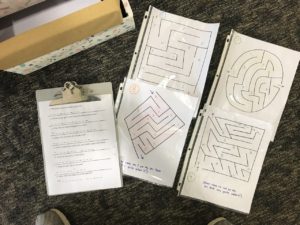
Monday’s game was a piece of paper with 8 “kid jokes” written on it, and blank lines where they could write the letters that would spell the punch line. The clues hidden inside each of the 8 boxes were 8 different mazes that had letters written in the maze. Tracing through the maze correctly would spell out the punch line to the jokes.
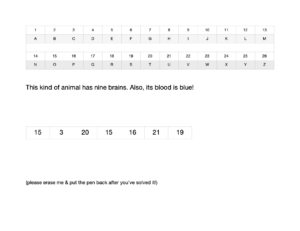
Tuesday’s game was a number substitution code to learn 8 different facts about animals. Each page inside the shoeboxes had a table showing A-Z and how they correlated to 1-26. Then it had an animal fact like, “This animal has nine brains. Also, its blood is blue!” Solving the number substitution code revealed the answers — i.e., “Octopus”!
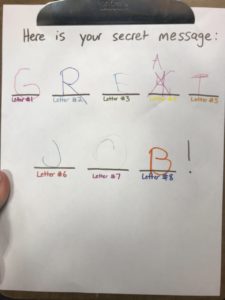
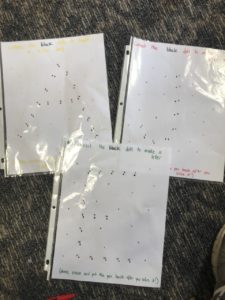
Wednesday’s game was a dot-to-dot. (I tried to vary whether each day would be simpler or more complex.) Each of the 8 shoeboxes contained a dot-to-dot that would spell out one big letter, and putting all the letters in order unscrambled a message that read “GREAT JOB”.
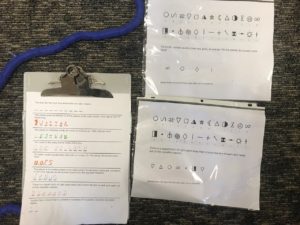
Thursday’s game was my “spy code” — very similar to Tuesday’s, but instead of substituting for numbers it was for symbols, and instead of facts about animals it was facts about space. Each page inside the shoeboxes had a table showing A-Z and their correlating symbols, a written space fact, and then decoding the symbols would lead to the answer.
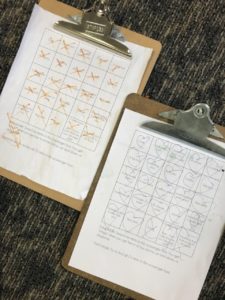
Friday’s game didn’t use the shoeboxes at all, but was just a 5×5 “Bingo card” style of page. I wrote items in each of the 5×5 squares that I knew would be around at camp, like, “a yellow marker”, “a smiley face,” “a tiny bug,” “something that smells good”, etc. At the bottom I wrote that they could solve it “easy mode” by finding any 5 in a row, or “hard mode” by finding all 25 things.
Out of the 30 kids who did camp, I think between 3-7 participated in the scavenger hunt/writing game each day. The first day, a bunch of them came up to me and handed me their papers, like, “I completed it!” and I think I did actually throw them for a loop by just being like, “Oh, cool! Way to go!” but not taking the papers or “turning them in” or offering them anything for them or anything like that. But then, they came back and continued doing them the rest of the week. Many of them forgot to ever show me that they finished them — they just enjoyed doing them, themselves (or showing their parents). And the ones who did continue to show me them did so with simply delight that they had enjoyed doing it.
***
If your child would be interested in trying Tuesday or Thursday’s activities — the number substitution puzzle, or the spy code puzzle — I’ve put them in a Google Drive folder here so that you can download them, print them, and do them yourself.
***
*I recently ran a week-long, sensory-rich, arts-and-crafts, child-led play day camp for 30 kids and their parents! I’ll be talking about it for awhile. See all my camp posts here.

